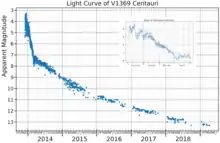V1369 Centauri
V1369 Centauri also known as Nova Centauri 2013 was a bright nova in the constellation Centaurus that occurred in 2013. It was discovered on December 2, 2013 by amateur astronomer John Seach in Australia with a magnitude of 5.5.[5][6] On December 14, 2013 it peaked at about magnitude 3.3, making it the brightest nova so far of this millennium.[7]
| Observation data Epoch J2000.0 Equinox J2000.0 | |
|---|---|
| Constellation | Centaurus |
| Right ascension | 13h 54m 45.363s[2] |
| Declination | −59° 09′ 04.17″[2] |
| Apparent magnitude (V) | 3.3 (max) |
| Astrometry | |
| Proper motion (μ) | RA: -19.096[2] mas/yr Dec.: -8.004[2] mas/yr |
| Parallax (π) | 3.6451[2] ± 0.9686[2] mas |
| Distance | 274+99 −58[2] pc |
| Characteristics | |
| Variable type | Nova[3] |
| Other designations | |
| Database references | |
| SIMBAD | data |

Nova Centauri 2013 was observed emitting gamma-rays between 7–10 December 2013 by the Fermi Gamma-ray Space Telescope.[8] The nova continued to brighten in gamma-rays and the peak coincided with the second optical maximum on 11 December 2013.[9]
The Swift Gamma-Ray Burst Mission detected X-ray emission from Nova Centauri 2013 on 18 and 25 February 2014 and 8 March 2014.[10]

In July 2015 it was announced that lithium has been detected in material ejected from Nova Centauri 2013. This is the first time lithium has been detected in a nova system.[11] The amount detected was less than a billionth of the mass of the Sun.[11] This finding is significant because it supports a theory that the extra lithium found in Population I stars (compared to Population II stars) comes from novae.[11]
References
- "Brand New Image of Nova Centauri 2013". ESO Picture of the Week. Retrieved 10 December 2013.
- Brown, A. G. A.; et al. (Gaia collaboration) (August 2018). "Gaia Data Release 2: Summary of the contents and survey properties". Astronomy & Astrophysics. 616. A1. arXiv:1804.09365. Bibcode:2018A&A...616A...1G. doi:10.1051/0004-6361/201833051. Gaia DR2 record for this source at VizieR.
- Aydi, E.; Chomiuk, L.; Izzo, L.; Harvey, E.J.; Leahy-McGregor, J.; Strader, J.; Buckley, D.A.H.; Sokolovsky, K.V.; Kawash, A.; Kochanek, C.S.; Linford, J.D.; Metzger, B.D.; Mukai, K.; Orio, M.; Shappee, B.J.; Shishkovsky, L.; Steinberg, E.; Swihart, S.J.; Sokoloski, J.L.; Walter, F.M.; Woudt, P.A. (December 2020). "Early Spectral Evolution of Classical Novae: Consistent Evidence for Multiple Distinct Outflows". The Astrophysical Journal. 905 (1): 62. arXiv:2010.07481. Bibcode:2020ApJ...905...62A. doi:10.3847/1538-4357/abc3bb. S2CID 222378358.
- "NOVA Cen 2013 – Nova". SIMBAD. Retrieved 2015-02-20.
- Dickinson, David (2013-12-04). "A Naked Eye Nova Erupts in Centaurus". Universe Today. Retrieved 2013-12-06.
- "Alert Notice 492: Nova Centauri 2013 = PNV J13544700-5909080". American Association of Variable Star Observers. 2013-12-04. Retrieved 2013-12-06.
- IAU Circ., 9266, 2 (2013). Edited by Green, D. W. E.
- Astronomer's Telegram #5649
- Astronomer's Telegram #5653
- Astronomer's Telegram #5966
- "First Detection of Lithium from an Exploding Star". ESO. Archived from the original on 1 August 2015. Retrieved 29 July 2015.
External links
- Naked-Eye Nova in Centaurus
- Light Curve Generator: AAVSO Data for Nova CEN 2013
- International Variable Star Index



